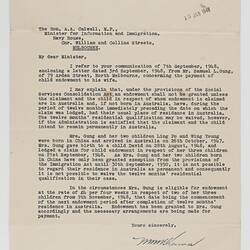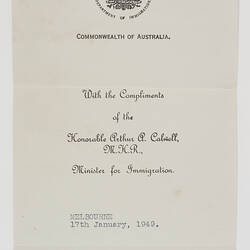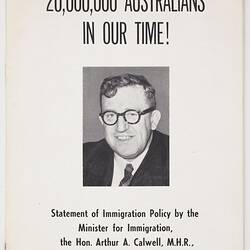Summary
Note: This object includes white superiority messaging. Such attitudes and beliefs are not condoned by Museums Victoria which considers them to be racist. Historical distance and context do not excuse or erase this fact.
Black and white printed pamphlet 'I Stand By White Australia' written by by Arthur A. Calwell, Minister for Immigration. This pamphlet reprint of the article first published by the Melbourne Argus on October 24, 1949. It is Calwell's response to the article 'Case for a Quota of Asian Migrants' by Professor W. Macmahon Ball, Professor of Political Science, University of Melbourne published in the Melbourne Argus on 17 October, 1949. Calwell had this article reprinted in pamphlet form for circulation among people who did not read the newspaper in which it originally appeared.
The context for this debate stems from the deportations of non-British aliens after World War II. During World War II a number of non-European refugees had been allowed to stay in Australia. While most left Australia after the war, about 800 wanted to remain as permanent residents. Calwell became the first Minister for Immigration in 1945 and was committed to a system which controlled immigration in accordance with the White Australia policy and enforced the deportation of prohibited immigrants. In October 1948 Calwell introduced the Aliens Deportation Bill and in 1949, the War-time Refugees Removal Bill. Also, in this period there were a number of court cases and personal stories of deportations being debated in the media. These debates in the public domain were the impetus for Professor Ball's original article and Calwell's response.
Calwell's argument in this pamphlet is that the introduction of a quota would be a form of appeasement to those prohibited migrants who wanted to stay, that a quota would be more discriminatory than the policy that was already in place and that Australia risked offending the Asian nations even more by introducing a quota.
Physical Description
Black and white printed pamphlet of four pages bound in the centre with two staples.
Significance
This pamphlet titled 'I Stand By White Australia' by Arthur A. Calwell, Minister for Immigration, published by the Melbourne Argus on October 24, 1949 is significant because it demonstrates Calwell's commitment to the White Australia policy and to the policy of deporting prohibited immigrants. It is also significant for the way in which it demonstrates the public debates of 1948/49 over the forced deportation of non-British aliens from Australia.
In 1901 the newly federated Australian government quickly introduced national legislation to protect its security and assert its sense of identity as a member of the British Empire. One of the first acts passed was the Immigration Restriction Act - known as the White Australia policy. The Immigration Restriction Act restricted the entry of non-Europeans by means of a dictation test, which could be given in languages other than English. People suffering physical or mental diseases, convicted criminals, prostitutes and those reliant on charity, were also refused entry. The Pacific Islands Labourers Act, 1901, enabled the deportation of over 9,000 Pacific Islander labourers who had been working in the sugar cane fields of Queensland and northern New South Wales. In 1903, the Commonwealth Naturalisation Act excluded all non-Europeans from becoming naturalised, and severely restricted their ability to bring spouses and children to Australia.
During World War II a number of non-European refugees, especially from the Dutch East Indies (now Indonesia), had been allowed to stay in Australia. While most left Australia after the war, about 800 wanted to remain as permanent residents. Calwell became the first minister for immigration in 1945 and was committed to a system which controlled immigration in accordance with the White Australia policy and enforced the deportation of prohibited immigrants. In October 1948 Calwell introduced the Aliens Deportation Bill and in 1949, the War-time Refugees Removal Bill. Also, in this period there were a number of court cases, including the highly publicised case of Annie O'Keefe, a wartime evacuee from Indonesia who had married an Australian, and other personal stories of deportations being debated in the media. These debates in the public domain were the impetus for Professor Ball's original article and Calwell's response.
More Information
-
Collecting Areas
-
Acquisition Information
Purchase
-
Author
-
Person Named
Professor William MacMahon Ball - University of Melbourne, Melbourne, Victoria, Australia, 24 Oct 1949
Written in response to an article by Professor Ball. -
Other Association (See Comments)
The Argus, Melbourne, Victoria, Australia, 24 Oct 1949
Article was originally printed in the Argus -
Inscriptions
Front cover: 'I Stand By White Australia By the Hon. Arthur A. Calwell, Minister for Immigration Reprint from the Melbourne Argus of October 24, 1949'
-
Classification
-
Category
-
Discipline
-
Type of item
-
Overall Dimensions - Closed
127 mm (Width), 203 mm (Height)
-
Keywords
Citizenship, Debates, Immigration, Immigration & Ethnic Affairs, Immigration Debates, Immigration Policies, Immigration Selection, Newspapers, Politicians, Publications, White Australia Policy




